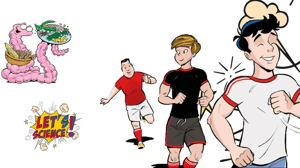The language of comics is an extraordinary way to promote science, especially for young people (but also for the not so young). Let’s Science, the IBSA Foundation project proves it.
Let's start at the beginning: what is a comic? There are lots of definitions.
Up until the 1960s, in Italy, they were called "giornaletti", which is perhaps a slightly derogative term, implying that they were a cultural by-product. Then, Umberto Eco, rehabilitated them in “Apocalypse Postponed”, making comics art with a capital A. Will Eisner calls comics “sequential art” and Scott McCloud has a semiotic approach to the white space between two cartoons, which he calls "closure".
But perhaps an anecdote about playwright Eduardo de Filippo also applies to comics. One day de Filippo received a phone call: "Hello, Maestro, this is the TV!". De Filippo replied, "Just a moment, I'll pass you the fridge!" The TV is just a domestic appliance and its value depends exclusively on its content.
Comics are a visual means of communication with a prevalently low target, whose quality comes from the stories that they contain. Of course comics are entertainment and their language is based on simplicity and immediacy. They’re not meant to be read in a library, but on a train, a bus or – why not? – on the toilet. Their format is also designed to fit in a coat pocket, so they can be carried around and read anywhere. So kids don’t associate reading them with studying, which is perhaps boring, complicated and difficult, but with entertainment.
Information through comics
This is why comics are perhaps the best way to present subjects to young people that they might not be that interested in.
Everyone remembers "The History of Italy in Comic Strips" by Enzo Biagi or "The Great Greek Myths in Comics" by Luciano De Crescenzo. But, for example, Scuola Romana dei Fumetti (The Rome Comic School) has even produced “The Opera in Comic Strips”, which present the stories of some of the melodramas performed during the opera season at the “Caracalla” in Rome. Eduardo de Filippo’s plays have also been transformed into comic strips by the Scuola Italiana di Comix. In short, comics don’t act as a substitute for the original text, nor do they simplify the complexity of works, but they stimulate curiosity and interest.
The association of words and pictures helps communication with users who are not necessarily “smart”, in the sense in which Umberto Eco uses the term to define a certain group of readers. One example is an Italian course for non-native speakers. The use of a graphic icon, associated with the corresponding word, obviously makes learning easier. This is not only because we immediately understand the meaning, but also because we connect a word with an image and therefore activate both logical-conceptual and visual memory.
However, we must never forget that comics are sequential art and therefore not to be confused with illustrated text. Comics express themselves through storytelling and not through a single drawing or a single vignette.
So it’s not enough to put a picture next to a written speech in order to communicate through comics. It involves truly transposing the information to be relayed into a comic strip.
Let’s Science and comics
Comics are traditionally associated with adventure. There are adventurous American superheroes like Batman and Spiderman and Italian heroes like Tex and Dylan Dog. They appeal because they are compelling, suspenseful and stimulate empathy and because we identify with the characters.
This is the challenge that Let’s Science has certainly met. Comics have become the focus of a complex project to promote science, involving experts and scientists from various fields, who meet and explain their subjects to middle school children in the Canton of Ticino and then write an educational text.
The students themselves write the theme of the comic and draw the characters. For example, viruses and bacteria become the heroes or villains of an adventure, like Batman and Joker.
mRNA, which we are currently talking about so much, has a body, a face and a costume and flies like Superman or runs like The Flash. Children enjoy imagining and designing them, but to do this, they have to understand them.
Professional scriptwriters, illustrators and colour artists from the Scuola Romana dei Fumetti will then produce the comic strip, which will be published, together with an expert's text, in booklet form by Carocci Editore and distributed to all secondary school classes in the Canton of Ticino.
But comics don’t only educate about science. Themes, chosen on a case-by-case basis by the DECS (the Department of Education, Arts and Sport) in partnership with the IBSA Foundation, also cover health education subjects, like nutrition. So comics become a vehicle not only for information but also for proper behaviour.
In this sense it’s a more effective method than a lecture or a paternalistic attitude, because it’s not just something that’s close to kids, but it’s made by the kids themselves. Comics are a medium for everyone and everyone can express themselves through them.

